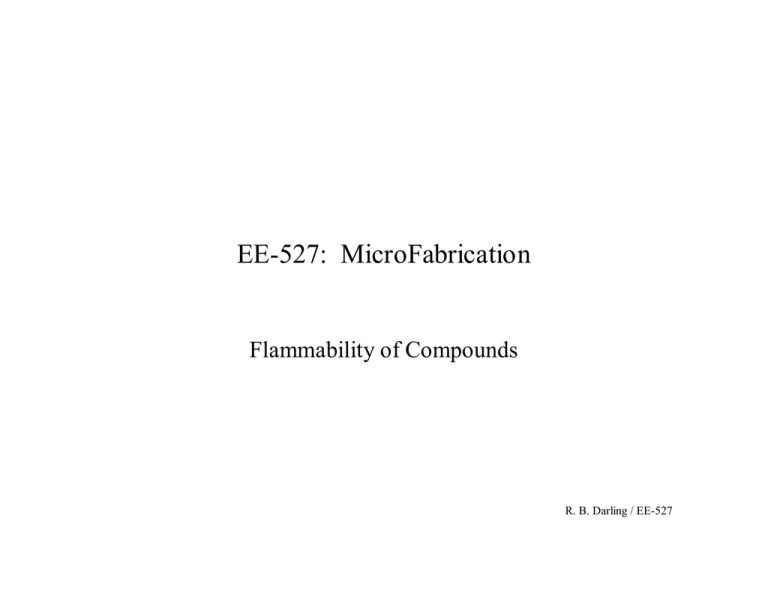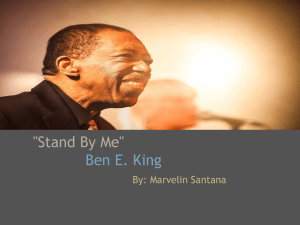EE-527: MicroFabrication Flammability of Compounds R. B. Darling / EE-527
advertisement

EE-527: MicroFabrication Flammability of Compounds R. B. Darling / EE-527 Flammability Range • Upper Explosive Limit (UEL) • Lower Explosive Limit (LEL) – volume percent of substance in air that will sustain combustion • Flammable Range: UEL - LEL, in percent – Example: xylene • UEL = 7.0% above this concentration, mixture is too rich to burn • LEL = 1.1% below this concentration, mixture is too lean to burn R. B. Darling / EE-527 Flammability Points • Flash Point: minimum temperature where a spark or flame will cause an instantaneous flash in the vapor space above a liquid • Fire Point: minimum temperature of a liquid to support continuous combustion after ignition via a spark or flame • Autoignition Point: minimum temperature at which a liquid spontaneously ignites without the introduction of a spark or flame – Example: xylene • • • • autoignition point (AP) = 496 C boiling point (BP) = 138 C fire point = 44 C [usually about 20 C higher than FP] flash point (FP) = 25 C R. B. Darling / EE-527 Fire Tetrahedron free radicals oxygen heat fuel BLEVE: boiling liquid expanding vapor explosion ---gas cylinders with liquefied contents R. B. Darling / EE-527 Fire Classifications • • • • Class A - common combustibles that leave coals or embers Class B - flammable liquids and gases Class C - fires in energized electrical equipment Class D - combustible metals: Al, Mg, Li, Na, K, Ti, Zr A B C D R. B. Darling / EE-527 Fire Extinguishants • Water - Class A fires only • Carbon Dioxide - Class A or B fires only – 2-25 lb. 830 psi cylinders of liquefied CO2 – soda-acid extinguishers (sodium bicarbonate) • spray: 2NaHCO3 + H2SO4 → Na2SO4 + 2H2O + 2CO2 • foam: 6NaHCO3 + Al2(SO4)3 → 3Na2SO4 + 2Al(OH)3 + 6CO2 • Carbon Tetrachloride - Class A-B-C – no longer used; can produce phosgene gas; CCl4 is carcinogenic • CCl4 + H2O → COCl2 + 2HCl • Halogenated Hydrocarbons - Class A-B-C • Dry Chemical Extinguishers - Class A-B-C R. B. Darling / EE-527 Halogen Fire Extinguishants • Halogenated Hydrocarbons (Halogens) – Halon numbering system: • • • • • 1st digit: no. of carbon atoms 2nd digit: no. of fluorine atoms 3rd digit: no. of chlorine atoms 4th digit: no. of bromine atoms 5th digit: no. of iodine atoms – Examples: • • • • Halon 104 = CCl4, carbon tetrachloride Halon 1011 = CH2ClBr, bromochloromethane Halon 1301 = CF3Br, bromotrifluoromethane Halon 1211 = CF2ClBr, bromochlorodifluoromethane R. B. Darling / EE-527 Halogen Fire Extinguishants • Halons 1301 and 1211 are most commonly used – – – – gases at room temperature heavier than air produce Br atoms which scavenge free radicals toxicity is controversial, but short term exposure appears safe • Halons are “clean” extinguishants – do not leave any solid or liquid by-products – only alternative for vaults, museums, libraries, aircraft, and sensitive electronics • Halons are greenhouse gases- displace atmospheric ozone – many halons are no longer manufactured; existing supply is all there is... R. B. Darling / EE-527 Dry Chemical Fire Extinguishants • • • • • Granular sodium chloride: NaCl, melts at 801 C Graphite: C, usually used for class D fires Sodium bicarbonate: NaHCO3 Potassium bicarbonate: KHCO3, “purple K” ABC: ammonium dihydrogen phosphate, NH4H2PO4 – – – – – 2NH4H2PO4 → P2O5 + 2NH3 + H2O endothermic reaction absorbs heat NH3 scavenges OH radicals most commonly used in household fire extinguishers H3PO4 is produced which is is corrosive to metals R. B. Darling / EE-527 Principles of Fire Extinguishants • Fuel must pyrolize into free radicals before combustion will occur: – H2 and O2 do not react until a spark is introduced to ignite them – HCl as a gas will not combust until exposed to sunlight – CH4 will not combust until ignited • Halon extinguishants are broken into free radicals with combine with and eliminate the free radicals of the fuel. • CO2 fire extinguishants are most effective in laboratory situations when used properly • Fire sprinklers are not intended to extinguish fires!!! – Their purpose is lay down a fog and suppress the smoke so that people can escape from a burning room R. B. Darling / EE-527


